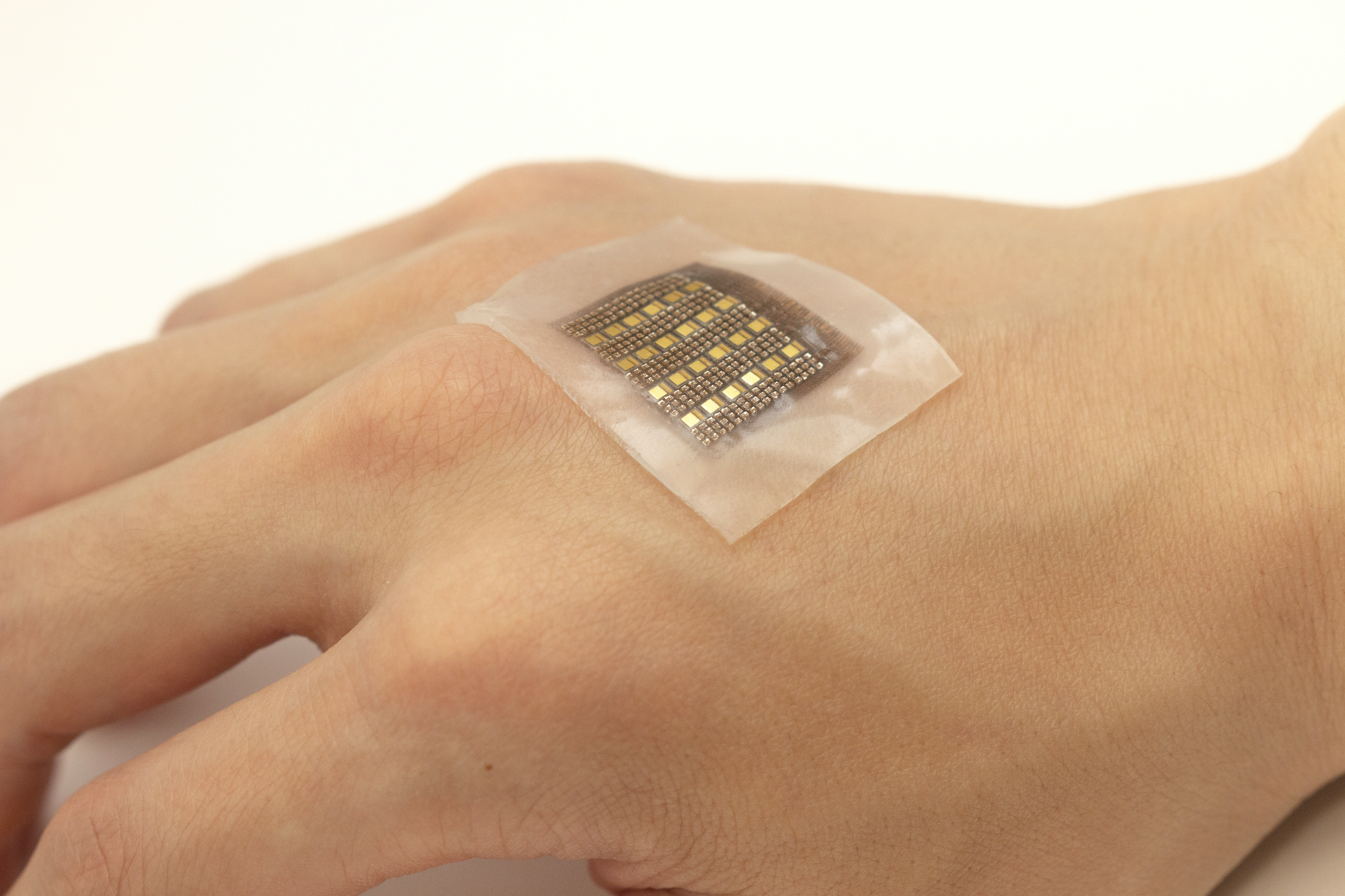
A photoacoustic sensor could help clinicians diagnose tumors, organ malfunctions and more. Photo by Xiaoxiang Gao for the Jacobs School of Engineering at UC San Diego.
A team of engineers at the University of California San Diego has developed an electronic patch that can monitor biomolecules in deep tissues, including hemoglobin. This gives medical professionals unprecedented access to crucial information that could help spot life-threatening conditions such as malignant tumors, organ dysfunction, cerebral or gut hemorrhages and more.
“The amount and location of hemoglobin in the body provide critical information about blood perfusion or accumulation in specific locations. Our device shows great potential in close monitoring of high-risk groups, enabling timely interventions at urgent moments,” said Sheng Xu, a professor of nanoengineering at UC San Diego and corresponding author of the study.
The paper, “A photoacoustic patch for three-dimensional imaging of hemoglobin and core temperature,” is published in the December 15, 2022 issue of Nature Communications.
 Low blood perfusion inside the body may cause severe organ dysfunctions and is associated with a range of ailments, including heart attacks and vascular diseases of the extremities. At the same time, abnormal blood accumulation in areas such as in the brain, abdomen or cysts can indicate cerebral or visceral hemorrhage or malignant tumors. Continuous monitoring can aid diagnosis of these conditions and help facilitate timely and potentially life-saving interventions.
Low blood perfusion inside the body may cause severe organ dysfunctions and is associated with a range of ailments, including heart attacks and vascular diseases of the extremities. At the same time, abnormal blood accumulation in areas such as in the brain, abdomen or cysts can indicate cerebral or visceral hemorrhage or malignant tumors. Continuous monitoring can aid diagnosis of these conditions and help facilitate timely and potentially life-saving interventions.The new, flexible, low form-factor wearable patch comfortably attaches to the skin, allowing for noninvasive long-term monitoring. Photo by Xiaoxiang Gao for the Jacobs School of Engineering at UC San Diego.
The new sensor overcomes some significant limitations in existing methods of monitoring biomolecules. Magnetic resonance imaging (MRI) and X-ray-computed tomography rely on bulky equipment that can be hard to procure and usually only provide information on the immediate status of the molecule, which makes them unsuitable for long-term biomolecule monitoring.
“Continuous monitoring is critical for timely interventions to prevent life-threatening conditions from worsening quickly,” said Xiangjun Chen, a nanoengineering PhD student in the Xu group and study co-author. “Wearable devices based on electrochemistry for biomolecules detection, not limited to hemoglobin, are good candidates for long-term wearable monitoring applications. However, the existing technologies only achieve the ability of skin-surface detection.”
The new, flexible, low form-factor wearable patch comfortably attaches to the skin, allowing for noninvasive long-term monitoring. It can perform three-dimensional mapping of hemoglobin with a submillimeter spatial resolution in deep tissues, down to centimeters below the skin, versus other wearable electrochemical devices that only sense the biomolecules on the skin surface. It can achieve high contrast to other tissues. Due to its optical selectivity, it can expand the range of detectable molecules, integrating different laser diodes with different wavelengths, along with its potential clinical applications.
The patch is equipped with arrays of laser diodes and piezoelectric transducers in its soft silicone polymer matrix. Laser diodes emit pulsed lasers into the tissues. Biomolecules in the tissue absorb the optical energy, and radiate acoustic waves into surrounding media.
“Piezoelectric transducers receive the acoustic waves, which are processed in an electrical system to reconstruct the spatial mapping of the wave-emitting biomolecules”, said Xiaoxiang Gao, a postdoctoral researcher in Xu’s lab and co-author of the study.
“With its low-power laser pulses, it is also much safer than X-ray techniques that have ionizing radiation”, said Hongjie Hu, a postdoctoral researcher in the Xu group and study coauthor.
Based on its success so far, the team plans to further develop the device, including shrinking the backend controlling system to a portable-sized device for laser diode driving and data acquisition, greatly expanding its flexibility and potential clinical utility.
They also plan to explore the wearable’s potential for core temperature monitoring. “Because the photoacoustic signal amplitude is proportional to the temperature, we have demonstrated core temperature monitoring on ex-vivo experiments,” Xu said. “However, validating the core temperature monitoring on the human body requires interventional calibration.”
They are continuing to work with physicians to pursue more potential clinical applications.
The work was supported in part by Air Force Research Laboratory under agreement number FA8650-18-2-5402, and the National Institutes of Health grants 1R21EB025521-01 (S.X.), 1R21EB027303-01A1 (S.X.), and 3R21EB027303-02S1 (S.X.).
Paper: “A photoacoustic patch for three-dimensional imaging of hemoglobin and core temperature.” Coauthors include Xiaoxiang Gao*, Department of Nanoengineering, UC San Diego; Xiangjun Chen*, Materials Science and Engineering Program, UC San Diego; Hongjie Hu*, Xinyu Wang and Wentong Yue, Department of Nanoengineering, UC San Diego; Jing Mu, Materials Science and Engineering Program; Zhiyuan Lou and Ruiqi Zhang Department of Nanoengineering, UC San Diego; Keren Shi, Materials Science and Engineering Program, UC San Diego and Materials Science and Engineering Program, UC Riverside; Xue Chen, Materials Science and Engineering Program, UC San Diego; Muyang Lin, Baiyan Qi and Sai Zhou, Department of Nanoengineering, UC San Diego; Chengchangfeng Lu, Yue Gu and Xinyi Yang, Department of Electrical and Computer Engineering, UC San Diego; Hong Ding, Yangzhi Zhu, Hao Huang, Yuxiang Ma and Mohan Li, Department of Nanoengineering, UC San Diego; Aditya Mishra, Materials Science and Engineering Program, UC San Diego; Joseph Wang, Department of Nanoengineering and Materials Science and Engineering Program, UC San Diego; and Sheng Xu, Department of Nanoengineering, Department of Electrical and Computer Engineering, Materials Science and Engineering Program and Department of Bioengineering, UC San Diego; Department of Radiology, School of Medicine, UC San Diego; and Softsonics, Inc.
*These authors contributed equally.
today.ucsd.edu


